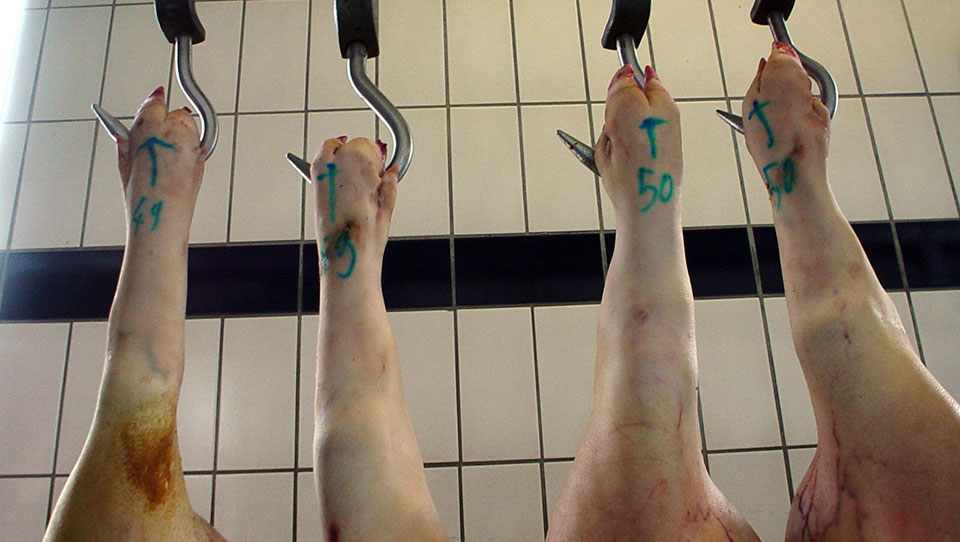
WASHINGTON—Apparently, nobody in the GOP Trump administration’s Agriculture Department has read Upton Sinclair’s classic The Jungle.
But the National Consumers League (NCL) and two unions involved with pork processing — and more importantly pork inspections — have. And they’re upset by a Trump USDA edict: A final rule speeding up pork production lines while yanking away federal inspectors.
Together, the NCL and the unions say that could endanger consumers’ health and workers’ job safety.
Acting at the behest of the agribusiness pork processing giants, USDA announced Sept. 17 it is imposing a new final pork processing plant inspection rule that lets plant managers and not trained USDA inspectors eye the swine carcasses all the way down the production line.
The USDA officials will come into play before the pork enters the line and at the end. Within 180 days, USDA wants every pork plant to follow its edict, with the largest plants doing so within three months and the smallest getting the full six months to adjust.
USDA said its new rule “is modernizing inspection at market hog slaughter establishments with a goal of protection of public health while allowing for food safety innovations.”
But the real goal is buried deep within the rule’s text, just as it was when USDA promulgated a similar edict for poultry plants: “To remove unnecessary regulatory obstacles to industry innovation by revoking maximum line speeds,” i.e. ending speed limits, “and allowing establishments flexibility to reconfigure evisceration lines.”
“Because this final rule requires establishment personnel”—i.e., managers—“to sort and remove unfit animals before” pre-pork line inspection by the Food Safety and Inspection Service “and trim and identify defects on carcasses and parts before post-mortem inspection by FSIS inspectors, the inspectors will be presented with healthier animals and carcasses that have fewer defects,” USDA claims.
“As a result, the FSIS can assign fewer inspectors to online inspection, freeing up resources to conduct more offline inspection activities.”
In plain English, what those sections mean is the pork processors can run the hog lines as fast as they want, even if the workers can’t keep up—and plant managers inspect the hogs along the way. And there will be fewer federal inspectors at the start and end of the lines.
Which is, of course, exactly what pork plants were like in the early 1900s in the days of Sinclair’s famous book exposing working conditions at slaughter plants on Chicago’s South Side. Those plants’ pork “products” at the end of the lines often contained not just pork, but bacteria, feces, sawdust and pieces of rats, and sometimes ground-up pieces of workers. That’s when there were not only no inspectors but no inspection agency, either.
Who benefits from Trump’s pork production rule? Well, a chart buried deep within it says the pork plants do, to the tune of $87.64 million more in profits, although the chart doesn’t say how long the plants will take to reap that gain.
How about consumers and their health? That’s dicier. To quote USDA: “The value of health benefits from averted cases of Salmonella,” a leading bacterium in diseased pork, “ranges from a $6.33 million decrease to a $24.62 million increase in health benefits, with a mean increase in benefits of $9.33 million, assuming a cost per illness of $3,682.”
Trump’s edict irked Sally Greenberg, executive director of the National Consumers League, which has campaigned for disease-free food – especially pork and chickens – for literally more than a century.
The Trump USDA’s “rule for unlimited line speed increases at swine slaughter plants puts the demands of companies and their quest for profits ahead of the worker safety and consumer protections. The rule also threatens the safety of our food supply,” Greenberg e-mailed to People’s World.
“The constant drive to increase pork plant speeds is a recipe for disaster, putting workers in greater jeopardy for injury and making impossible demands on the women and men in these plants to operate at unrealistic speeds. We stand with the United Food and Commercial Workers, whose members work in these plants, in opposing the rule. We urge the USDA to put the safety of workers and consumers first and stop this dangerous rule.“

UFCW posted a long analysis of the Trump USDA’s rule and its failings, including the food safety danger and the line speedup danger to workers. Union President Marc Perrone said Trump’s pork production rule “sends a clear message this administration values corporate profits more than the safety of America’s food and workers. Increasing pork plant line speeds is a reckless corporate giveaway that would put thousands of workers in harm’s way as they are forced to meet impossible demands.”
J. David Cox, whose Government Employees (AFGE) represents the 4,000 swine safety inspectors, took a similar tack. He too called on USDA to drop its pork production rule. Cox also made the connection to The Jungle.
“The rule is detrimental to our food inspectors and to the American public whose food they keep safe. It will result in the loss of 40% of federal inspector jobs in hog slaughter plants and instead turn much of their work over to company employees who aren’t trained or paid to do inspections.” The rule has no requirement that pork plants train employees in inspections.
“This rule…will instead take us back a century to a time when there was little government oversight over the meatpacking industry.”










